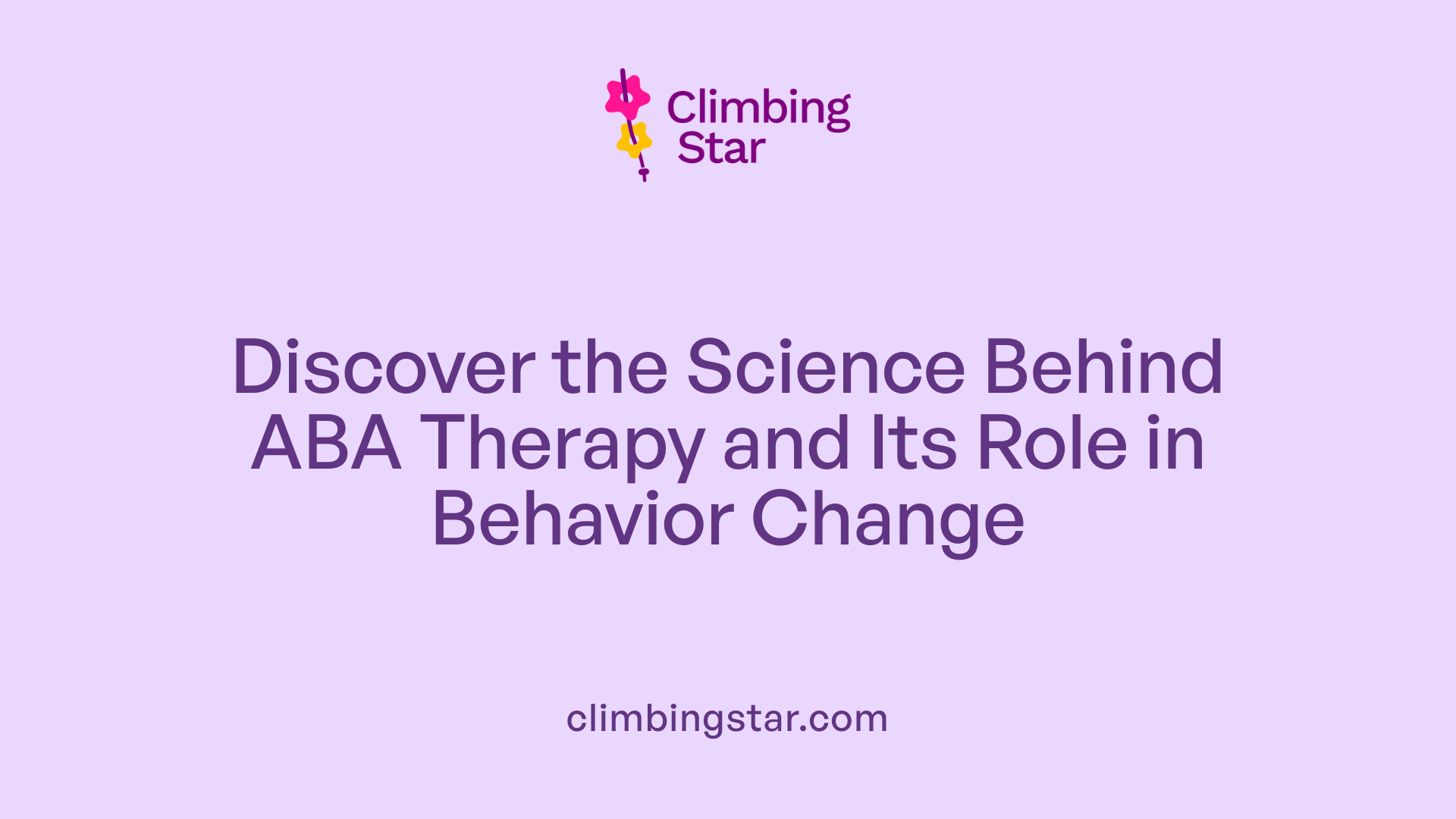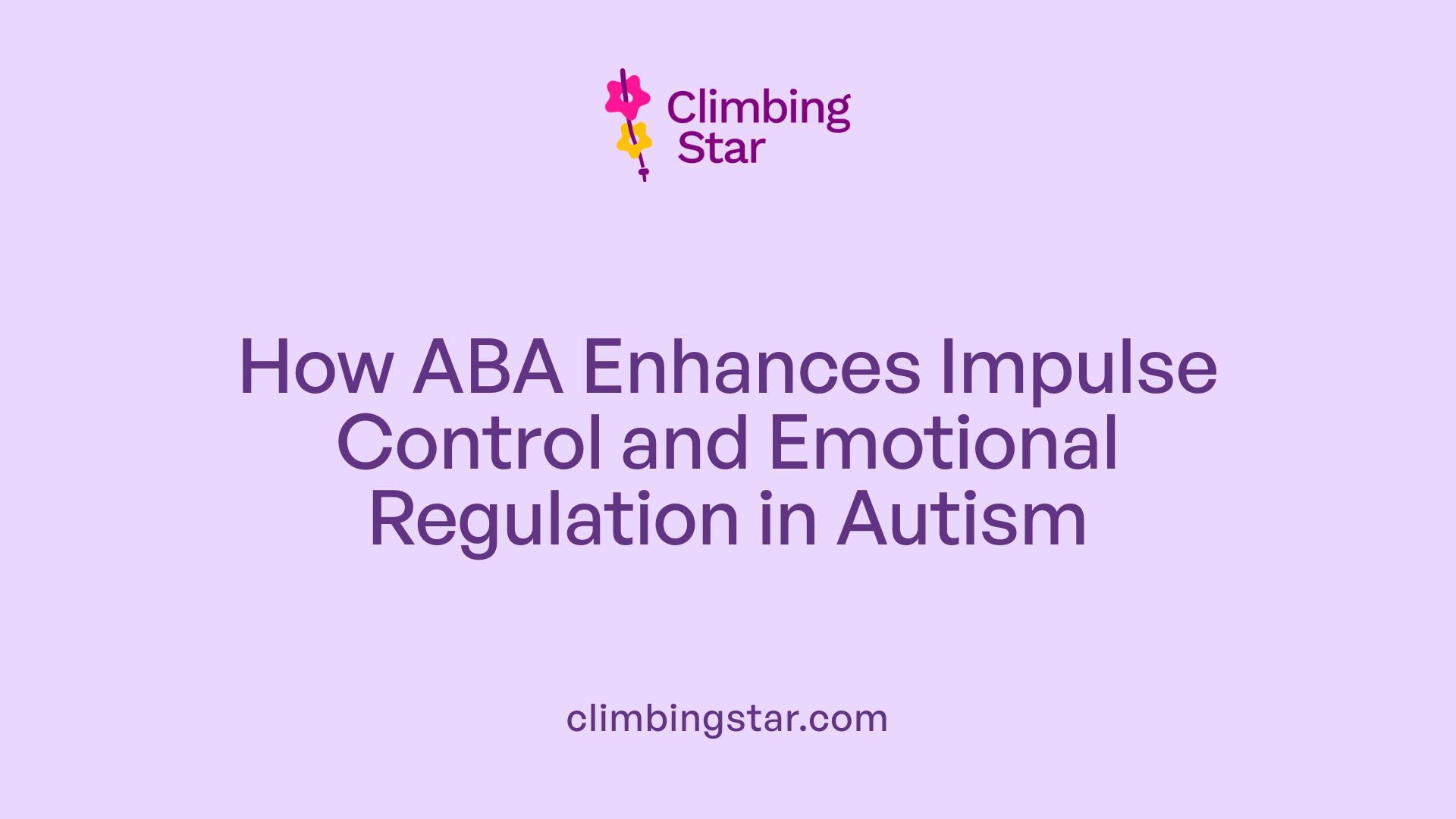Understanding Autism and Impulse Control Challenges
Impulse control difficulties are commonly observed in individuals with autism spectrum disorder (ASD), manifesting as emotional outbursts, difficulty waiting, and acting without forethought. These behaviors stem from underlying executive dysfunctions that impact planning, organization, and self-regulation. Addressing these challenges is crucial for improving the quality of life and functional independence of those with autism. Applied Behavior Analysis (ABA) therapy offers evidence-based interventions tailored to helping individuals manage impulsivity and develop essential behavioral skills.
What is Applied Behavior Analysis (ABA) Therapy?

What is Applied Behavior Analysis (ABA) therapy?
Applied Behavior Analysis (ABA) is a science-driven approach grounded in behavior analysis that seeks to produce meaningful, lasting changes in important behaviors. It focuses on increasing functional skills such as communication, social interaction, and daily living abilities, while reducing behaviors that interfere with learning and social engagement.
How does ABA therapy work?
ABA therapy uses evidence-based techniques to observe and modify behavior by analyzing antecedents (what happens before a behavior), the behavior itself, and consequences (what happens after). This detailed approach allows therapists to develop individualized treatment plans tailored to the unique needs of each person.
Techniques and individualized planning
ABA interventions include diverse strategies such as discrete trial training, activity schedules, token economies, video modeling, and self-management. These methods are carefully selected and adapted to meet a person's developmental level and specific goals, whether it’s teaching new skills or decreasing challenging behaviors.
Who provides ABA therapy?
ABA services are delivered by qualified professionals certified by the Behavior Analyst Certification Board (BACB). These include Board Certified Behavior Analysts (BCBAs), assistant BCBAs, and Registered Behavior Technicians (RBTs), ensuring that treatment follows rigorous ethical and professional standards.
Ongoing assessment and progress monitoring
A defining feature of ABA therapy is the continuous collection of data and regular assessments to evaluate effectiveness. Therapists use this data to adjust interventions as needed, ensuring goals are met and that treatment remains responsive and individualized.
Together, these elements make ABA therapy a structured, research-supported, and personalized approach that has shown significant benefits, particularly when started early in individuals with autism spectrum disorder.
Who Provides ABA Therapy and How Are Providers Qualified?

Certification and Training Requirements for ABA Providers
ABA therapy is administered by trained professionals who have undergone rigorous education and certification processes. The primary credential is the Board Certified Behavior Analyst (BCBA), which requires advanced study in behavior analysis, supervised practical experience, and passing a certification exam. There are also Board Certified Assistant Behavior Analysts (BCaBAs), who support BCBAs and have a bachelor’s or master’s level certification, and Registered Behavior Technicians (RBTs), who implement therapy under supervision and complete specific training and assessments.
Roles of BCBAs, BCaBAs, and Registered Behavior Technicians
BCBAs lead the design, implementation, and supervision of ABA treatment programs. They conduct behavioral assessments, develop individualized intervention plans, and evaluate treatment effectiveness. BCaBAs assist BCBAs by implementing treatment plans and monitoring progress under close supervision. RBTs provide direct therapy services to clients, applying ABA techniques during sessions and gathering data on behavior.
Settings Where ABA Is Delivered
ABA services are versatile and can be delivered in various environments. Common settings include in-home therapy, outpatient clinics, schools, and community programs. This flexibility ensures that interventions integrate seamlessly into clients' daily lives, enhancing generalization of skills.
Organizations Offering ABA Services
Numerous organizations provide ABA therapy across the United States. Examples include Behavior TLC, Inc., Inspire ND, Include Kids/Empower Behavioral Health, Spectrum of Hope LLC, and Texana Children’s Center for Autism. These providers typically serve broad age ranges and tailor intervention strategies to individual needs.
Populations Served Including Autism and Other Developmental Disorders
While ABA is widely recognized for its effectiveness with autism spectrum disorder, it also benefits individuals with other developmental disorders such as ADHD, OCD, brain injuries, and PTSD. Clients range from young children to adults and often receive individualized plans focused on improving communication, social skills, daily living abilities, and reducing interfering behaviors.
| Provider Role | Certification Level | Primary Responsibilities |
|---|---|---|
| Board Certified Behavior Analyst (BCBA) | Master’s degree + BCBA certification | Develops and supervises ABA therapy plans |
| Board Certified Assistant Behavior Analyst (BCaBA) | Bachelor’s or Master’s + BCaBA certification | Supports BCBA, helps implement plans |
| Registered Behavior Technician (RBT) | RBT credential | Delivers direct ABA interventions under supervision |
ABA therapy providers are committed to delivering evidence-based interventions tailored to the client’s unique needs, fostering meaningful and lasting improvements in behavior and skills.
How ABA Therapy Supports Impulse Control in Individuals with Autism

How does ABA therapy support individuals with autism?
ABA therapy supports individuals with autism by employing evidence-based techniques designed to understand and influence behavior through environmental factors. It focuses on increasing positive behaviors—like communication and social interaction—while reducing challenging behaviors such as impulsivity, using methods like positive reinforcement and individualized treatment plans.
Connection between autism, impulse control challenges, and executive dysfunction
Many children with autism struggle with impulse control, which is linked to executive dysfunction—a challenge in planning, organizing, and regulating behavior. This difficulty can manifest as emotional outbursts, grabbing items impulsively, or leaving tasks unfinished. ABA directly addresses these challenges by teaching coping and self-regulation skills.
Use of reinforcement techniques to promote self-control and delay gratification
ABA utilizes positive reinforcement to reward impulse-controlled behaviors. For example, when a child successfully waits their turn or responds calmly during frustrating situations, ABA interventions acknowledge and encourage these behaviors, helping to build stronger self-control and delay gratification.
Structured activities and goal setting in therapy
Therapists incorporate structured activities and clear goal setting within ABA sessions. These help individuals practice self-regulation in controlled environments with predictable routines, fostering gradual improvements in impulse control and functional behavior.
Therapist-led activities and social skills training
Social skills training and therapist-guided activities are core ABA strategies. These sessions teach children how to interpret social cues, manage emotions, and communicate needs without impulsive reactions, improving both social engagement and emotional regulation.
Collaboration with family and educators
ABA therapy encourages collaboration among families, educators, and therapists to create consistent strategies across settings. Structured routines and reinforcement at home and school promote generalization of impulse control skills and support long-term behavioral improvements.
Specific ABA Techniques Targeting Impulse Control

What are some common techniques used in ABA therapy?
ABA therapy incorporates several strategies to address impulse control, promoting adaptive and socially acceptable behaviors.
Positive Reinforcement and Neutral Redirection Positive reinforcement rewards behaviors such as impulse control and non-aggression, encouraging their repetition. Neutral redirection gently guides individuals away from undesired behaviors without punishment, helping them learn appropriate ways to express needs.
Activity Schedules and Visual Supports Visual tools, such as activity schedules and visual activity timers, help structure daily routines and provide clear expectations. These supports aid individuals in anticipating transitions and managing impulses through predictable sequences.
Token Economies and Contingency Management Token economies reward desired behaviors with tokens exchangeable for preferred items or activities. Common in adult settings and justice facilities, these systems reinforce self-control and prosocial behavior.
Prompting and Fading Strategies ABA therapists use prompts—verbal, visual, or physical cues—to initiate appropriate responses and gradually reduce assistance as independence grows. This helps individuals learn self-regulation in manageable stages.
Self-Management Training and Behavior Chaining Self-management teaches individuals to monitor and regulate their own behaviors, often involving setting goals and tracking progress. Behavior chaining breaks down complex tasks into smaller steps, making impulse control skills easier to acquire.
Together, these techniques form a comprehensive approach tailored to each individual's needs, setting a foundation for improved impulse control and overall functioning.
Effectiveness and Adaptability of ABA Therapy for Autism Spectrum Disorder

What evidence supports ABA's impact on social, communication, and adaptive skills?
Numerous scientific studies and systematic reviews have demonstrated that ABA is effective in enhancing critical skills for individuals with autism. These include improvements in social interactions, communication, academic abilities, vocational skills, and daily living activities. The therapy uses developmentally appropriate methods such as token economies, video modeling, and direct instruction, all supported by decades of rigorous research. Institutions like the Surgeon General and the National Autism Center endorse ABA based on this evidence.
Does ABA therapy work for all individuals on the autism spectrum?
ABA is widely recognized as a valid treatment method for autism, but its effectiveness varies among individuals. Factors influencing outcomes include the specific behavioral goals, the individual's responsiveness, and the quality and intensity of the intervention. While some individuals may achieve significant developmental gains, others may show more modest improvements. Adaptability of ABA allows tailoring programs to meet various developmental and behavioral needs, including co-occurring challenges such as ADHD.
How important is early intensive intervention?
Early intensive ABA, usually provided at more than 20 hours per week before age 4, is associated with the most substantial developmental progress. Early intervention can reduce the need for further services later in life by addressing developmental delays early. Timely and concentrated therapy helps maximize skill acquisition and can influence long-term outcomes positively.
How does ABA integrate with other therapies?
ABA often works best when combined with other approaches. Speech and language therapy enhances communication skills, while occupational therapy addresses sensory and daily living challenges. Educational programs like TEACCH and social-relational methods complement ABA by enriching learning environments and social bonding. Pharmacological treatments and psychological therapies may also manage co-occurring symptoms, though they do not replace ABA’s focus on behavior change.
What role does caregiver involvement play?
Active caregiver participation is vital to the success of ABA therapy. Caregivers are trained in techniques like neutral redirection and positive reinforcement to manage behaviors at home and in the community. Collaboration between therapists, families, and educators creates consistency, reinforcing progress across settings. Aligning interventions with family values and resources ensures socially valid and compassionate care, further enhancing outcomes.
Collaborative Approaches and Support Systems in Managing Impulse Control
Why is it important for family, educators, and therapists to work together?
Effective management of impulse control challenges in individuals with autism requires a collaborative approach involving family members, educators, and therapists. This teamwork ensures consistent understanding and reinforcement of coping strategies across all environments, from home to school to therapy sessions. When all parties coordinate, they create a unified support network that promotes positive behavioral changes.
How do structured routines and social skills training help?
Structured routines provide predictability, which helps reduce anxiety and impulsive reactions. Social skills training teaches individuals appropriate ways to interact and respond in various situations, improving impulse control by enhancing self-regulation capabilities.
What is caregiver training in neutral redirection?
Caregivers are trained to use neutral redirection, a technique that calmly guides individuals away from aggressive or impulsive behaviors toward socially acceptable alternatives without punishment or reacting to the unwanted behavior. This approach encourages effective communication of needs while minimizing reinforcement of negative behaviors.
How does building consistency and reinforcement improve daily environments?
Consistency in responses to behaviors across caregivers and educators strengthens learning and behavior change. Reinforcing positive behaviors regularly encourages repetition of self-controlled actions, embedding impulse regulation into daily life.
What resources support these collaborative efforts?
Resources such as the ABA Toolbox and ChildMind.org provide practical strategies, educational materials, and guidance to families and professionals managing impulse control challenges. These tools supplement interventions, offering evidence-based approaches tailored to individual needs.
These combined collaborative strategies and support systems form a comprehensive framework that significantly enhances impulse control development and behavioral outcomes for individuals with autism.
ABA in Relation to Other Behavioral and Developmental Therapies
How Does ABA Compare with Developmental, Speech, and Occupational Therapies?
ABA primarily focuses on modifying behavior through reinforcement and structured interventions to improve socially important skills. In contrast, developmental approaches target enhancement of language, social, and physical skills, often complementing ABA therapy. Speech and language therapy specifically aims to boost communication abilities, while occupational therapy, including sensory integration, assists individuals in managing daily living skills and sensory responses. Educational methods like TEACCH emphasize adapting learning environments for structured, visual-based instruction, and social-relational strategies focus on emotional bonds and social skills development.
How Is ABA Used Alongside Pharmacological and Psychological Treatments?
ABA addresses core behaviors in autism and impulse control by teaching coping and self-regulation strategies. Pharmacological treatments, while not targeting core autism symptoms, manage co-occurring issues such as anxiety or hyperactivity. Psychological therapies like cognitive-behavioral therapy (CBT) help individuals handle related mental health concerns, such as anxiety and depression, often complementing ABA’s behavioral interventions.
What Complementary and Alternative Therapies Are Commonly Used?
Many caregivers integrate complementary treatments, including specialized diets, herbal supplements, animal-assisted therapy, arts therapies, and relaxation techniques to support traditional therapies. While these can be beneficial, consultation with healthcare providers ensures safety and appropriate integration into treatment plans.
How Does ABA Apply to Broader Populations Including ADHD?
ABA’s applications extend beyond autism to include disorders like ADHD, where it supports behavioral management alongside medication. Behavioral techniques such as differential reinforcement, discrete trial training, and self-management help reduce impulsivity and improve functioning in various settings. This versatility underscores ABA’s role in addressing diverse developmental and behavioral challenges.
How Is Holistic and Individualized Treatment Planning Achieved?
Effective interventions combine assessments by Board Certified Behavior Analysts (BCBAs) to tailor plans based on individual strengths, needs, and family values. Collaboration with families, educators, and therapists ensures consistent reinforcement and support, creating structured routines and social skills training that enhance skill generalization and impulse control across settings.
Moving Forward with Evidence-Based Support for Impulse Control in Autism
Applied Behavior Analysis (ABA) therapy stands out as a scientifically grounded and adaptable approach to addressing impulse control challenges faced by individuals with autism spectrum disorder. Through a comprehensive range of techniques, individualized treatment plans, and collaborative efforts involving families and professionals, ABA fosters the development of essential self-regulation and social skills. While ABA's effectiveness can vary depending on individual needs, its widespread acceptance and integration with complementary therapies underscore its vital role in improving the lives of those with autism. Continued research, provider training, and family engagement remain key to refining approaches and maximizing positive outcomes in impulse control management.
References
- A Treatment Summary of Applied Behavior Analysis
- ABA in the Treatment of Aggression and Impulse Control
- Treatment and Intervention for Autism Spectrum Disorder
- ABA Therapy for ADHD Treatment | Manhattan Psychology
- Autism and Impulse Control: Building Self-Regulation Skills
- ABA Techniques: Strategies for Behavior Analysts - GSEP Blog
- ABA Therapy Examples, Definition & Techniques
- Applied Behavior Analysis (ABA)







